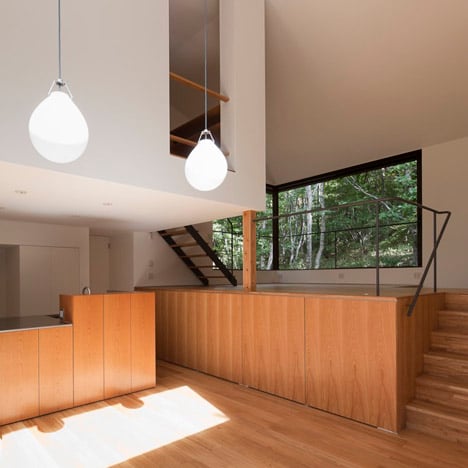Tokyo architects Naoi have completed a three-tiered woodland summerhouse at Japanese holiday spot Nasu Kogen.
Named Tiered Lodge, the split-level house contains a kitchen and dining room on its lower floor, a living room on the middle level and a mezzanine loft and bedroom above.
Large parts of the facade slide open to help cool the house during the warm summer months.
Residents enter the house across a decked balcony and seating area, which leads straight into the lower floor dining room.
Naoi also recently completed a square house with an off-centre courtyard - see it here.
Photography is by Hiroshi Ueda.
Here's some more text from the architects:
Tiered Lodge
For this project, we were commissioned to build a second home for a husband-and-wife couple and their young son. The client requested a simple space that would allow him to take a step back from the daily demands of his busy schedule and help to rejuvenate his body and mind.
The site is located in Nasu Kogen, a well-known summer resort area in Japan that lies at an altitude of 1,000m. Dense groves of deciduous trees can be found nearby, making the area a popular retreat during the sweltering summer months. In the winter, however, temperatures drop below freezing point, and snowfall of up to 80cm has been recorded.
Elevation varies a total of 8m across the entire site running from east to west. Making use of this sloping gradient, we decided to design a residence that would create a sense of continuity with the forest around it.
The first step was to configure two volumes lying next to each other that corresponded to the contours of the terrain, and then to shift these volumes along both the horizontal and vertical axes. Through this process, we were able to create a level surface that could bridge the gap between the cross-section of the lodge and the forest outside it, while also prompting an awareness of changes in the topography of the site.
The space that emerged as a result of this elevation difference and shifts in the surface of the floor showcases subtle variations in the size of each volume, the windows, and the quality of the light in each interior. This structure enabled us to endow what is essentially a single-roomed space with remarkable depth and variation.
The dining and kitchen area, which opens directly onto the outdoor terrace and features an open stairwell, is situated in the southwest corner of the site, making it a fluid space with a distinctively bright, open quality.
The living room situated on the far eastern end of the site, on the other hand, is configured as a zone of peace and quiet where the family can gather around the fireplace.
The loft, located on a mezzanine that lies above the living room, is a suspended space lying in mid-air that offers the inhabitants a commanding, elevated view of the trees outside the lodge.
The sliding doors at the corner of the dining and living area, which can be stowed inside the wall, give the boundaries between the interior and exterior of the house an ambiguous character. For the façade, special efforts were made to preserve the integrity of the forested landscape by installing exterior walls covered in cedar boards and a continuous series of slit windows.
By paying close attention to the possibilities presented by a given site, and giving spatial form to its distinctive qualities, we hope to be able to continue creating buildings that showcase the beauty that belongs to the realm of architecture.

